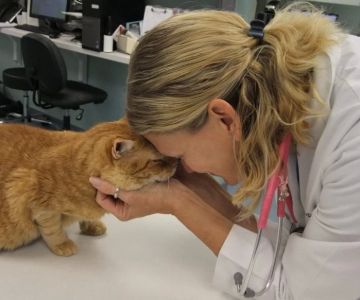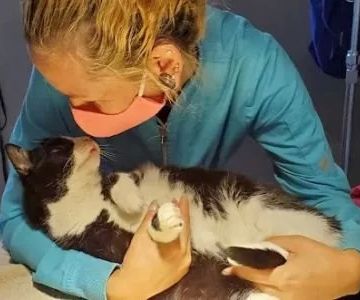- 1‑What is Feline Neurologic Disease?
- 2‑Common Symptoms of Feline Neurologic Disorders
- 3‑How to Diagnose Feline Neurologic Disease
- 4‑Treatment Options for Feline Neurologic Disorders
- 5‑How Hidden Brook Veterinary Can Help
1. What is Feline Neurologic Disease?
Feline neurologic disease refers to a range of conditions that affect the nervous system of cats, including the brain, spinal cord, and peripheral nerves. Just like humans, cats can experience neurological issues, and these conditions can manifest in various ways, from mild symptoms like changes in behavior to more severe manifestations such as paralysis or seizures.
Neurologic disorders in cats can be congenital (present at birth) or acquired (developing due to injury, infection, or disease). Understanding these diseases is vital for any cat owner, as early recognition and treatment are essential for the best possible outcome.
2. Common Symptoms of Feline Neurologic Disorders
Recognizing the signs of a neurologic disease in your cat can be challenging, as the symptoms can vary widely depending on the type and severity of the disorder. However, there are several common signs that may indicate a neurological issue:
2.1 Behavior Changes
Cats with neurologic diseases may exhibit noticeable changes in behavior. These changes can include increased aggression, confusion, disorientation, or a sudden loss of coordination. If your cat seems unusually lethargic, disoriented, or has difficulty navigating familiar areas, it may be a sign of a neurological issue.
2.2 Seizures and Tremors
Seizures are one of the more severe symptoms of neurologic disease in cats. If your cat experiences uncontrolled shaking, muscle twitching, or convulsions, this is a clear indication of a serious problem. Tremors may also be present even when your cat is awake and alert, particularly in the legs or head.
2.3 Loss of Coordination and Mobility
Cats suffering from neurologic diseases may show signs of uncoordinated movements. They may have difficulty walking, appear unsteady on their feet, or drag their limbs. Affected cats may also struggle to jump or climb, which is typically a natural ability for them.
2.4 Abnormal Eye Movements
Abnormal eye movements, such as constant flickering or jerking (nystagmus), can be a sign of neurologic disease. In some cases, the cat may also experience pupil dilation, unusual head tilting, or even vision loss.
3. How to Diagnose Feline Neurologic Disease
Diagnosing neurologic disease in cats requires a comprehensive approach. Veterinarians typically begin with a thorough physical examination and detailed history of your cat's symptoms. The process may involve several diagnostic techniques:
3.1 Physical and Neurologic Exam
During the initial exam, the vet will assess your cat's reflexes, gait, and coordination. They may also test for muscle strength and sensitivity in the limbs and head. These basic evaluations help identify the severity of the neurologic dysfunction.
3.2 Imaging and Blood Tests
To get a clearer picture of the issue, your vet may recommend diagnostic imaging such as X-rays, CT scans, or MRI scans. These tests help identify structural problems in the brain or spine, such as tumors or herniated discs. Blood tests can also reveal infections, metabolic imbalances, or other underlying conditions that might contribute to neurologic symptoms.
3.3 Spinal Tap and Cerebrospinal Fluid Analysis
In some cases, a spinal tap (or lumbar puncture) may be performed to obtain cerebrospinal fluid (CSF) for analysis. This fluid can help diagnose conditions like meningitis, encephalitis, or other inflammatory processes affecting the nervous system.
4. Treatment Options for Feline Neurologic Disorders
Treatment for feline neurologic disorders depends on the specific condition, its severity, and the underlying cause. In some cases, treatment may involve medication, surgery, or a combination of therapies.
4.1 Medications
Medications are commonly used to manage symptoms of neurologic diseases. Anti-seizure medications such as phenobarbital or levetiracetam are prescribed for cats with epilepsy or seizures. For conditions like inflammation or infections affecting the nervous system, steroids or antibiotics may be necessary.
4.2 Surgery
If a structural issue such as a spinal tumor or herniated disc is identified, surgery may be recommended to remove the obstruction and relieve pressure on the nervous system. Surgery is often a last resort for serious conditions but can provide significant relief for certain cases.
4.3 Supportive Care and Rehabilitation
For cats with neurologic issues affecting movement or coordination, rehabilitation therapy can be beneficial. Physical therapy, hydrotherapy, and acupuncture may help improve mobility and overall quality of life. Supportive care, including nutritional support and pain management, is often an important part of treatment as well.
5. How Hidden Brook Veterinary Can Help
At Hidden Brook Veterinary, we specialize in diagnosing and treating a variety of neurologic diseases in pets, including felines. Our team of experienced veterinarians offers advanced diagnostic tools and treatment options tailored to your cat’s specific needs.
If you suspect your cat is suffering from a neurologic condition, don't wait. Early diagnosis and intervention can make a significant difference in the outcome. Contact Hidden Brook Veterinary today to schedule an appointment or to learn more about how we can help keep your pet healthy and comfortable.











